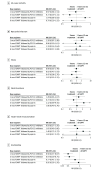Short-Term Dual Antiplatelet Therapy After Drug-Eluting Stenting in Patients With Acute Coronary Syndromes: A Systematic Review and Network Meta-Analysis
- PMID: 39382876
- PMCID: PMC11581547
- DOI: 10.1001/jamacardio.2024.3216
Short-Term Dual Antiplatelet Therapy After Drug-Eluting Stenting in Patients With Acute Coronary Syndromes: A Systematic Review and Network Meta-Analysis
Abstract
Importance: The optimal duration of dual antiplatelet therapy (DAPT) in patients with acute coronary syndromes (ACS) undergoing percutaneous coronary intervention (PCI) remains under debate.
Objectives: To analyze the efficacy and safety of DAPT strategies in patients with ACS using a bayesian network meta-analysis.
Data sources: MEDLINE, Embase, Cochrane, and LILACS databases were searched from inception to April 8, 2024.
Study selection: Randomized clinical trials (RCTs) comparing DAPT duration strategies in patients with ACS undergoing PCI were selected. Short-term strategies (1 month of DAPT followed by P2Y12 inhibitors, 3 months of DAPT followed by P2Y12 inhibitors, 3 months of DAPT followed by aspirin, and 6 months of DAPT followed by aspirin) were compared with conventional 12 months of DAPT.
Data extraction and synthesis: This systematic review and network meta-analysis followed the Preferred Reporting Items for Systematic Reviews and Meta-Analysis guidelines. The risk ratio (RR) with a 95% credible interval (CrI) was calculated within a bayesian random-effects network meta-analysis. Treatments were ranked using surface under the cumulative ranking (SUCRA).
Main outcomes and measures: The primary efficacy end point was major adverse cardiac and cerebrovascular events (MACCE); the primary safety end point was major bleeding.
Results: A total of 15 RCTs randomizing 35 326 patients (mean [SD] age, 63.1 [11.1] years; 26 954 male [76.3%]; 11 339 STEMI [32.1%]) with ACS were included. A total of 24 797 patients (70.2%) received potent P2Y12 inhibitors (ticagrelor or prasugrel). Compared with 12 months of DAPT, 1 month of DAPT followed by P2Y12 inhibitors reduced major bleeding (RR, 0.47; 95% CrI, 0.26-0.74) with no difference in MACCE (RR, 1.00; 95% CrI, 0.70-1.41). No significant differences were observed in MACCE incidence between strategies, although CrIs were wide. SUCRA ranked 1 month of DAPT followed by P2Y12 inhibitors as the best for reducing major bleeding and 3 months of DAPT followed by P2Y12 inhibitors as optimal for reducing MACCE (RR, 0.85; 95% CrI, 0.56-1.21).
Conclusion and relevance: Results of this systematic review and network meta-analysis reveal that, in patients with ACS undergoing PCI with DES, 1 month of DAPT followed by potent P2Y12 inhibitor monotherapy was associated with a reduction in major bleeding without increasing MACCE when compared with 12 months of DAPT. However, an increased risk of MACCE cannot be excluded, and 3 months of DAPT followed by potent P2Y12 inhibitor monotherapy was ranked as the best option to reduce MACCE. Because most patients receiving P2Y12 inhibitor monotherapy were taking ticagrelor, the safety of stopping aspirin in those taking clopidogrel remains unclear.
Conflict of interest statement
Figures



References
-
- Lawton JS, Tamis-Holland JE, Bangalore S, et al. 2021 ACC/AHA/SCAI guideline for coronary artery revascularization: executive summary: a report of the American College of Cardiology/American Heart Association joint committee on clinical practice guidelines. Circulation. 2022;145(3):e4-e17. doi: 10.1161/CIR.0000000000001039 - DOI - PubMed
Publication types
MeSH terms
Substances
LinkOut - more resources
Full Text Sources
Medical
Miscellaneous

